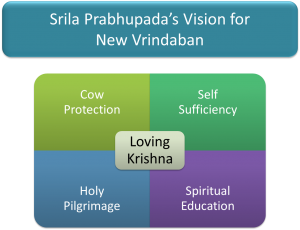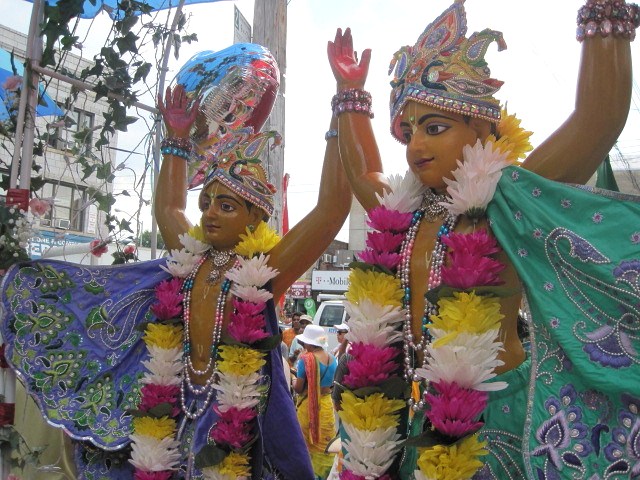Hare Krishna!
Please accept our humble obeisances!
All glories to Srila Prabhupada!
All glories to Sri Guru and Sri Gauranga!
Appearance day of Lord Balaram:Lord Balaram's appearance day anniversary was on Tuesday 20th Aug 2013.
We at ISKCON Scarborough will be celebrating the Appearance day of Lord Balaram on Friday 23rd Aug 2013.
We are extremely honoured to announce that a special class on Lord Balaram will be given by HG Rupanuga das prabhu.
Program starts at 6.45 pm with Tulasi Arti on Friday 23rd Aug 2013
Who is Lord Balarama?The Supreme Personality of Godhead, Krishna, is the fountainhead of all incarnations. Lord Balarama is His second body. They are both one and the same identity. They differ only in form. Balarama is the first bodily expansion of Krishna, and He assists in Lord Krishna's transcendental pastimes. He is the source of the entire spiritual world and is the adi-guru, the original spiritual master.
Descent of Lord BalaramaWhenever Krishna appears in the material world, He is accompanied by His associates and paraphernalia. Five thousand years ago when Krishna descended into the material world, He was first preceded by Baladeva.
When Baladeva appeared as the seventh child in the womb of Devaki, she could understand that this was a divine child and this made her all the more concerned about His safety. Even Kamsa could sense His potency and he became fearful, thinking he may have been tricked by the prophecy that he will be slain only by the eight child of Devaki. At this time Krishna instructed Yogamaya, His internal potency, to transfer the unborn child from the womb of Devaki to that of Rohini, one of the other wives of Vasudeva, who was hiding from Kamsa in the house of Nanda Maharaja in Gokul.
In this way Balarama was born in Gokul under the protection of Nanda Maharaja.
Garga Muni the venerable kulaguru (family priest) of the Yadu dynasty revealed “ This child, the son of Rohiṇī, will give all happiness to His relatives and friends by His transcendental qualities. Therefore He will be known as Rāma. And because He will manifest extraordinary bodily strength, He will also be known as Bala. Moreover, because He unites two families — Vasudeva's family and the family of Nanda Mahārāja — He will be known as Saṅkarṣaṇa”.
Snan Yatra:ISKCON Scarborough's 1st Snan Yatra will take place on Sunday 25th Aug 2013.
This grand Snan yatra is a precursor to ISKCON Scarborough's 1st Annual Jagannath Cultural program that will take place on Saturday- September 7th 2013 at Milliken Park.
Program for Sunday - 25th Aug 201310.30 am to 11am - Tulasi Puja/Guru Puja
11 am to 12 noon - Grand Abhishek on Lord Jagannath, Lord Baladev and Subhadra Devi
12 noon to 12.30 pm- Arti
12.30 pm to 1 pm - class on Lord Jagannath's Snan Yatra by HG Bhakti Yoga das prabhu
1 pm to 1.15 pm- Group chanting
1.15 pm- Grand Vegetarian prasadam
The Snan yatra bathing ceremony has been going on since the time of the carving of the 'Dharu-brahman' Deities of Lord Jagannath, Lord Balaram, and Subhadra Devi in Sri Purushottam Kshetra (Jagannath Puri) thousands of years ago, commemorating Their sacred appearance for the devotees
We warmly welcome you, your family and friends to join us for the auspicious programs this Friday/Sunday
With best wishes from,
ISKCON Scarborough
3500 McNicoll Avenue, Unit #3,
Scarborough,Ontario,
Canada,M1V4C7
Email Address:
iskconscarborough@hotmail.com
website:
www.iskconscarborough.com 152 photos: Preaching program at the Bhakti Center of NYC with Radhanath Swami, August 23 2013 Read more ›
152 photos: Preaching program at the Bhakti Center of NYC with Radhanath Swami, August 23 2013 Read more ›  152 photos: Preaching program at the Bhakti Center of NYC with Radhanath Swami, August 23 2013 Read more ›
152 photos: Preaching program at the Bhakti Center of NYC with Radhanath Swami, August 23 2013 Read more ›  This temple will give all a chance to understand who we really are and what is our relationship to GOD and thus make our lives successful & attain to the real happiness that we all are seeking for. Please browse through our website and we hope to serve you in your journey of self-realisation
This temple will give all a chance to understand who we really are and what is our relationship to GOD and thus make our lives successful & attain to the real happiness that we all are seeking for. Please browse through our website and we hope to serve you in your journey of self-realisation 









 23 photos: Harinama in Abranovce (Presov, Slovakia)
23 photos: Harinama in Abranovce (Presov, Slovakia)  Amsterdam Rathayatra took place last Sunday. There must be a few movies about this Rathayatra, this movie is put together from a Prasad distribution angle, sorry about the funky sound track in advance. Movie put together by Achinta Rupa Prabhu
Amsterdam Rathayatra took place last Sunday. There must be a few movies about this Rathayatra, this movie is put together from a Prasad distribution angle, sorry about the funky sound track in advance. Movie put together by Achinta Rupa Prabhu  Sacinandana Swami: We have just concluded our 3rd Kirtan-Mela in Germany, and as before many devotees have experienced how through the kirtans in association with many - an extraordinary spiritual experience of Krishna´s presence being created. That has surely increased their faith like anything.
Sacinandana Swami: We have just concluded our 3rd Kirtan-Mela in Germany, and as before many devotees have experienced how through the kirtans in association with many - an extraordinary spiritual experience of Krishna´s presence being created. That has surely increased their faith like anything.  Srila Prabhupada saw the urgency to spread this knowledge and I am preaching to myself when I say it is our duty to take this mission to every town and village while we still have some life in our bones. Your servant Parasuram Das
Srila Prabhupada saw the urgency to spread this knowledge and I am preaching to myself when I say it is our duty to take this mission to every town and village while we still have some life in our bones. Your servant Parasuram Das  Kripamoya das: This is the last in a short series of posts about ISKCON membership. I hope you’ve found them either interesting or useful.
Kripamoya das: This is the last in a short series of posts about ISKCON membership. I hope you’ve found them either interesting or useful.  77 photos: Sri Balaram Purnima, Hare Krishna Baltimore, Aug 20, 2013
77 photos: Sri Balaram Purnima, Hare Krishna Baltimore, Aug 20, 2013  After discussions with the art department and the TOVP’s own Managing Director, Sadbhuja Das, an exciting agreement was reached where Nitco will provide blue and gold tiles
After discussions with the art department and the TOVP’s own Managing Director, Sadbhuja Das, an exciting agreement was reached where Nitco will provide blue and gold tiles  Damodara Pandit das: The course will cover three handbooks entitled Devotional Practice; Theology and Philosophy; and Vaisnava Culture. Classes will be held four days a week from 4.00-6.00 p.m. We will dive into the ever-blissful ocean of harinama-sankirtana three times a week
Damodara Pandit das: The course will cover three handbooks entitled Devotional Practice; Theology and Philosophy; and Vaisnava Culture. Classes will be held four days a week from 4.00-6.00 p.m. We will dive into the ever-blissful ocean of harinama-sankirtana three times a week 
 For the pleasure of Srila Prabhupada this page contains the following results for the month of July 2013
For the pleasure of Srila Prabhupada this page contains the following results for the month of July 2013  36 Photos: Krishna Balarama Ratha Yatra of Queens, New York
36 Photos: Krishna Balarama Ratha Yatra of Queens, New York 